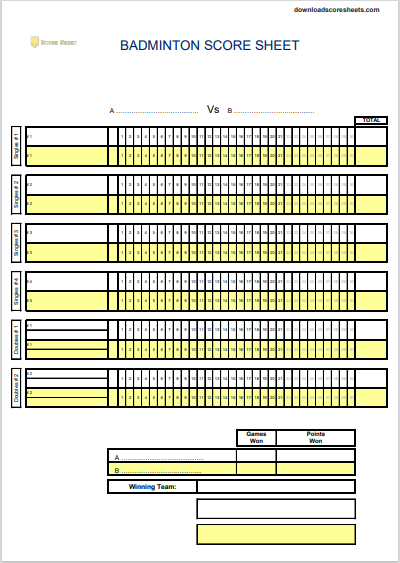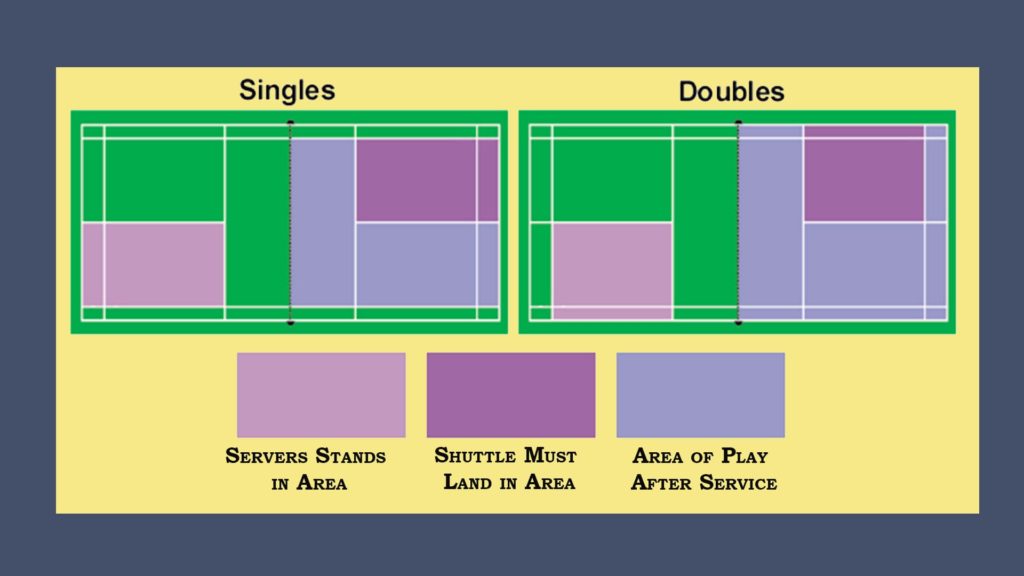Badminton Score Sheet with Complete Guide to Brilliance
Badminton is a sport that combines speed, agility, and strategic finesse. Let’s take you on a journey through the fascinating history, rules, and score system of this dynamic racket sport that has captivated millions around the globe. Badminton Score Sheet gives you a way to track the records of your gameplay.

A Glimpse into Badminton’s Past
Badminton’s roots trace back to ancient civilizations, where a game similar to today’s badminton was played in various cultures. The modern version we know today gained popularity in British India in the mid-19th century. Fast forward, and badminton made its Olympic debut in 1992, solidifying its status as a premier racquet sport.
The Anatomy of a Badminton Match
The Basics
Badminton is played on a rectangular court divided by a badminton net. Players use lightweight badminton rackets to hit a shuttlecock, a feathered or synthetic projectile, over the net. The court is further divided into singles and doubles, each with its own set of rules. The rules of the game are very crucial part of the game to follow and win on terms.
Serving Up Success
Serving is a crucial aspect of badminton. Players must serve diagonally, and the shuttlecock must pass over the net and land within the opponent’s service court. Mastering various serve techniques is essential for gaining an early advantage.
The Dance of Footwork
Success in badminton hinges on nimble footwork. Players must swiftly navigate the court, responding to opponents’ shots and maintaining optimal positioning. Efficient footwork ensures players can reach and return shots effectively.
Rallying Brilliance
The heart of badminton lies in the rally. Players engage in a fast-paced exchange of shots, employing techniques like smashes, drops, clears, and net play. The strategic use of these shots can turn the tide of a match.
Scoring in Badminton
Scoring in badminton follows a straightforward yet dynamic system that adds an extra layer of excitement to each rally. Let’s delve deeper into the intricacies of how points are earned and the structure of a badminton match:
Scoring Points
- Points are scored when the shuttlecock lands within the opponent’s court.
- A point is also earned if the opponent commits a fault, such as hitting the shuttlecock out of bounds or into the net. And you add it to your Badminton Score Sheet right away.
- The server’s side continues to serve and accrue points until the opponent wins a rally, at which point they take over the serve.
Rally-Scoring System
- Unlike traditional scoring systems where points are only won on one’s own serve, badminton Score Sheet uses a rally-scoring system. This means that points can be scored on every serve, regardless of which side served.
- The server or serving pair earns a point each time they win a rally, irrespective of who served first.
Deciding Game
- If the match reaches a deciding third game, players switch sides when the leading score reaches 11 points. This ensures fairness, as factors like drift in indoor arenas can affect gameplay.
- The same scoring principles apply in the deciding game, with the first side to reach 21 points (or with a two-point lead after 20-all) securing the match.
Best-of-Three Format
- Badminton matches are organised in a best-of-three format. To win the overall match, a player or team must secure victory in two out of three games. You can use the same Badminton Score Sheet for all format matches.
- Each game is played independently, and the first side to reach 21 points (or with a two-point lead after 20-all) takes that particular game.
Match Points
- Matches are typically played to 21 points, but a player or team must win by a margin of at least two points.
- If the score reaches 20-all, the game continues until one side establishes a two-point lead.
- This ensures that the winning side not only reaches the 21-point threshold but does so with a clear advantage.
Understanding this scoring system adds depth to the strategic aspect of badminton. Players must not only focus on shot accuracy and agility but also manage their points effectively to emerge victorious in a match.
Free Badminton Score Sheet Download
To make tracking your points and maintaining a comprehensive record easier, we’re offering a free printable badminton score sheet. Keep your games organised and strategize your way to victory. Click here to download your free badminton score sheet.

Strategies for Success
Singles vs. Doubles Tactics
- Singles and doubles each present unique challenges. Singles play demands endurance and individual skill, while doubles requires seamless communication and coordination with a partner. Strategies vary, with doubles often involving quick exchanges and net play.
Singles Play Tactics
- Endurance and Precision: Singles matches demand exceptional endurance as players cover the entire court on their own. Precision is key, requiring players to carefully place shots to exploit opponents’ weaknesses.
- Utilizing the Full Court: In singles, players need to cover the full court efficiently. Strategic use of both sidelines and depth can force opponents into difficult positions, creating opportunities for powerful shots.
Doubles Play Tactics
- Communication and Coordination: Doubles is as much about teamwork as individual skill. Communication between partners is crucial to coordinate movements and cover the court effectively.
- Net Dominance: Doubles often sees more net play. Players strategically position themselves at the net to intercept shots and set up quick, offensive plays. This requires anticipation and lightning-fast reflexes.
- Front-Back Strategy: One player typically plays at the front of the court (near the net) while the other covers the back. This front-back strategy allows for a seamless blend of offensive and defensive moves.

Exploiting Weaknesses
Successful players analyze opponents’ weaknesses and adapt their game accordingly.
- Analyzing Opponent’s Game: Understanding an opponent’s strengths and weaknesses is fundamental. In singles, exploit their weaker side or capitalize on mobility limitations. In doubles, target the weaker player through strategic shot placement.
- Varying Shot Selection: Keep opponents guessing by varying shot selection. Mix powerful smashes with delicate drops and deceptive clears to disrupt their rhythm and make it challenging to predict your next move.
Conclusion
Badminton is not merely a sport; it’s a symphony of skill, strategy, and sheer athleticism. As you delve into the world of badminton, remember that it’s a sport for everyone, from casual enthusiasts to competitive players. So, grab a badminton set, find a court, and experience the exhilaration of badminton for yourself and start maintaining your scores on Badminton Score Sheet.





